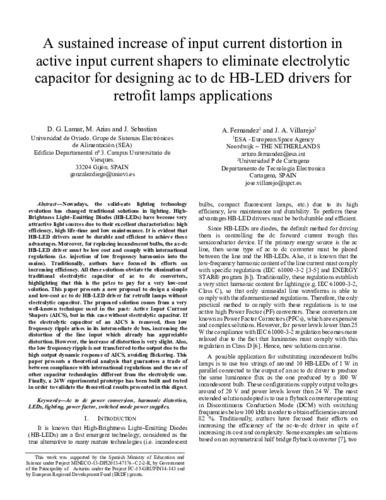A sustained increase of input current distortion in active input current shapers to eliminate electrolytic capacitor for designing ac to dc HB-LED drivers for retrofit lamps applications
Palabra(s) clave:
Ac to dc power conversion
Harmonic distortion
LEDs
Power factor
Switched mode power supplies
Fecha de publicación:
Editorial:
IEEE
Versión del editor:
Descripción física:
Resumen:
Nowadays, the solid-sate lighting technology evolution has changed traditional solutions in lighting. High-Brightness Light–Emitting Diodes (HB-LEDs) have become very attractive light sources due to their excellent characteristics: high efficiency, high life-time and low maintenance. It is evident that HB-LED drivers must be durable and efficient to achieve these advantages. Moreover, for replacing incandescent bulbs, the ac-dc HB-LED driver must be low cost and comply with international regulations (i.e. injection of low frequency harmonics into the mains). Traditionally, authors have focused its efforts on increasing efficiency. All these solutions obviate the elimination of traditional electrolytic capacitor of ac to dc converters, highlighting that this is the price to pay for a very low-cost solution. This paper presents a new proposal to design a simple and low-cost ac to dc HB-LED driver for retrofit lamps without electrolytic capacitor. The proposed solution comes from a very well-known technique used in the past: Active Input Current Shapers (AICS), but in this case without electrolytic capacitor. If the electrolytic capacitor of an AICS is removed, then low frequency ripple arises in its intermediate dc bus, increasing the distortion of the line input which already has appreciable distortion. However, the increase of distortion is very slight. Also, the low frequency ripple is not transferred to the output due to the high output dynamic response of AICS, avoiding flickering. This paper presents a theoretical analysis that guarantees a trade of between compliance with international regulations and the use of other capacitor technologies different from the electrolytic one. Finally, a 24W experimental prototype has been built and tested in order to validate the theoretical results presented in this digest
Nowadays, the solid-sate lighting technology evolution has changed traditional solutions in lighting. High-Brightness Light–Emitting Diodes (HB-LEDs) have become very attractive light sources due to their excellent characteristics: high efficiency, high life-time and low maintenance. It is evident that HB-LED drivers must be durable and efficient to achieve these advantages. Moreover, for replacing incandescent bulbs, the ac-dc HB-LED driver must be low cost and comply with international regulations (i.e. injection of low frequency harmonics into the mains). Traditionally, authors have focused its efforts on increasing efficiency. All these solutions obviate the elimination of traditional electrolytic capacitor of ac to dc converters, highlighting that this is the price to pay for a very low-cost solution. This paper presents a new proposal to design a simple and low-cost ac to dc HB-LED driver for retrofit lamps without electrolytic capacitor. The proposed solution comes from a very well-known technique used in the past: Active Input Current Shapers (AICS), but in this case without electrolytic capacitor. If the electrolytic capacitor of an AICS is removed, then low frequency ripple arises in its intermediate dc bus, increasing the distortion of the line input which already has appreciable distortion. However, the increase of distortion is very slight. Also, the low frequency ripple is not transferred to the output due to the high output dynamic response of AICS, avoiding flickering. This paper presents a theoretical analysis that guarantees a trade of between compliance with international regulations and the use of other capacitor technologies different from the electrolytic one. Finally, a 24W experimental prototype has been built and tested in order to validate the theoretical results presented in this digest
ISBN:
Patrocinado por:
Spanish Ministry of Education and Science under Project MINECO-13-DPI2013-47176- C2-2-R, by Government of the Principality of Asturias under the Project FC-15-GRUPIN14-143 and by European Regional Development Fund (ERDF) grants
Colecciones
Ficheros en el ítem




